Pavlohrad
Pavlograd[1] (Ukrainian: Павлоград, pronounced [pɐu̯loˈɦrɑd]; Russian: Павлогра́д, pronounced [pəvlɐˈɡrat]) is an industrial city in central Ukraine, located within the Dnipropetrovsk Oblast. Administratively, Pavlohrad is incorporated as the town of oblast significance and serves as the administrative center of Pavlohrad Raion which it does not belong to. Its population is approximately 105,238 (2019 est.)[2].
Pavlohrad Павлоград Pavlograd | |
|---|---|
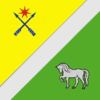 Flag  Coat of arms | |
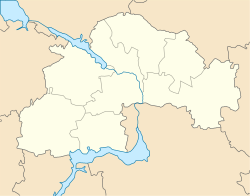 Pavlohrad  Pavlohrad | |
| Coordinates: 48°31′0″N 35°52′0″E | |
| Country | |
| Oblast | |
| Raion | City of Pavlohrad |
| Established | 1779 |
| City rights | 1784 |
| Government | |
| • Mayor | Anatoliy Vershina |
| Area | |
| • Total | 59.3 km2 (22.9 sq mi) |
| Highest elevation | 71 m (233 ft) |
| Population (2019) | |
| • Total | 105 238 |
| Postal code | 51400-51429 |
| Area code(s) | +380-5632 |
| Website | http://pavlograd-official.org/ |
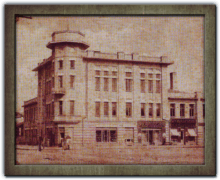
The rivers of Vovcha (runs through the city 12.85 kilometres (7.98 mi) towards the Samara River), Hnizdka (3.9 kilometres (2.4 mi)), Kocherha (2.9 kilometres (1.8 mi)) flow through Pavlohrad. The area of the city is 59.3 square kilometres (22.9 sq mi). There are 20 schools and 1 lyceum in the city.
History
Pavlohrad is one of the oldest settlements in Dnipropetrovsk oblast. The first references to it are from the 17th century.
At the beginning of the 1770s, Zaporozhian Cossack Matvii Khizhnyak built winter quarters, which soon became known as sloboda Matviivka. In 1779, Matveevka was renamed to Luhanske, as the latter became headquarters of the Luhansk pikemen regiment headed by M. I. Golinishchev-Kutuzov. With the establishment of Yekaterinoslav Viceroyalty in 1783, Pavlohrad, named in honor of the future Emperor Paul І (r. 1796–1801), became a part of this administrative unit as a district town. In 1784, Pavlohrad received city status.
There were 426 homes and 2419 inhabitants in the city at the end of 18th century. The citizens of Pavlograd lived in wattle and daub. The first stone building was the Svyato-Vosnesensky Cathedral on Soborna ploshcha (eng.: cathedral square). The first blazon of the city was affirmed on July 29, 1811, the second one on September 26, 1979. The first citizens were Cossacks of Samarsky and Kalmiussky Palanki and demobilized military. The city plan by Scottish architect W. Geste was affirmed by emperor Nicholas I on July 31, 1831.
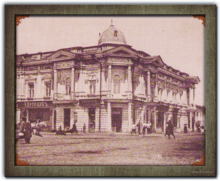
In 1871, local merchant A.K.Shalin was elected the first head of the city. The central street was named after him (ul. Shalinskaya, (eng: Shalinsky street) later renamed ul. Lenina, (eng.: Lenin street)). Merchant of ІІ Guild A.V.Permanin was elected as city governor in 1892. Under his leadership the city started to develop rapidly: a lot of churches, temples, barracks, gymnasiums, factories and plants were built.
In the 1870s, a railway was built between St. Petersburg and Simferopol, passing through Pavlohrad. In 1896, the Golenishchev-Kutuzov family built the "Earl's Theatre".
In 1930, an uprising against Soviet rule took place in Pavlohrad. From 1780 to 1941, a significant Jewish community existed in the city. The pre-Holocaust Jewish population was approximately 4,000. The city was destroyed in 1941 during the Nazi occupation. During the Holocaust a concentration camp was located in Pavlohrad and a large part of the community died during the war and during the mass executions. The Pavlohrad Jewish cemetery contains not only Jewish, but also Christian burials, which were agreed to by the leaders of the local Jewish community in 1995.[3] On May 22, 2011, it was reported that unknown persons had desecrated the cemetery in the town - tombstones were turned over and broken in an apparently anti-Semitic act.[4]
Pavlohrad Mechanical Plant
The city is home to Pavlohrad Mechanical Plant (PMZ) that was established in December 1963 as a specialized production facility of the Plant no. 586 (now Pivdenmash Production Association). PMZ is a factory dedicated to assembly, perfection and production of solid-fueled rocket engines and missiles. By 1975 PMZ became the largest solid-rocket factory within the Ministry of General Machine Building of USSR. PMZ made fuel tanks for booster rockets and plastic ICBM rocket motor casings; parts, components, and assemblies for aerospace systems manufacturing.
Gallery
 A pedestrian alley in midtown Pavlohrad
A pedestrian alley in midtown Pavlohrad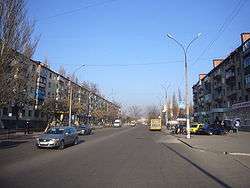 Karl Marx Street
Karl Marx Street- Pavlograd Railway Station
- Tank monument, Pavlograd
 Remains of Lenin monument in Pavlohrad
Remains of Lenin monument in Pavlohrad.jpg) Dormition Cathedral Pavlograd
Dormition Cathedral Pavlograd Vernicle Cathedral Pavlograd
Vernicle Cathedral Pavlograd Holubytsky church in Pavlohrad
Holubytsky church in Pavlohrad
International relations
References
- "Alexeenko, Fyodor Nikitich (1882-1904)". jstor.org. Retrieved 5 September 2015. Cite journal requires
|journal=(help) - "Чисельність наявного населення України (Actual population of Ukraine)" (PDF) (in Ukrainian). State Statistics Service of Ukraine. Retrieved 23 May 2020.
- "PAVLOHRAD JEWISH CEMETERY". lo-tishkach. Retrieved 30 September 2012.
- "Cemetery desecrated". CFCA. Retrieved 30 September 2012.
External links
- The murder of the Jews of Pavlohrad during World War II, at Yad Vashem website.
| Wikimedia Commons has media related to Pavlohrad. |